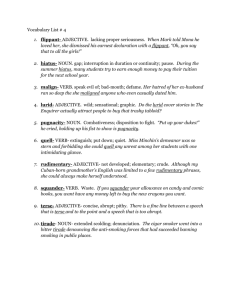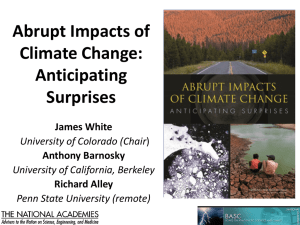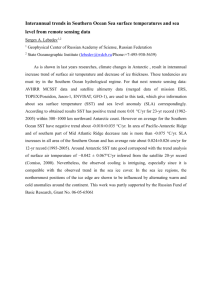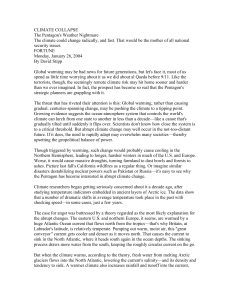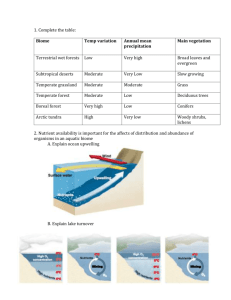Near Term Long Term Outlook (for an
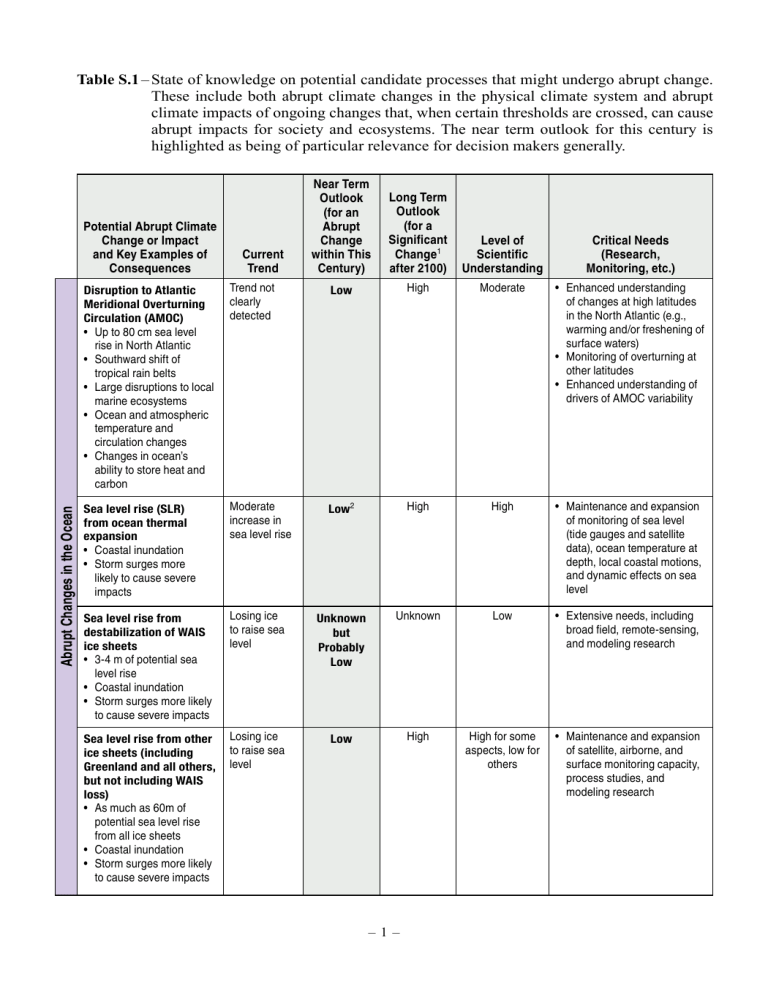
Table S.1
– State of knowledge on potential candidate processes that might undergo abrupt change.
These include both abrupt climate changes in the physical climate system and abrupt climate impacts of ongoing changes that, when certain thresholds are crossed, can cause abrupt impacts for society and ecosystems. The near term outlook for this century is highlighted as being of particular relevance for decision makers generally.
Potential Abrupt Climate
Change or Impact and Key Examples of
Consequences
Disruption to Atlantic
Meridional Overturning
Circulation (AMOC)
• Up to 80 cm sea level rise in North Atlantic
• Southward shift of tropical rain belts
• Large disruptions to local marine ecosystems
• Ocean and atmospheric temperature and circulation changes
• Changes in ocean’s ability to store heat and carbon
Current
Trend
Trend not clearly detected
Sea level rise (SLR) from ocean thermal expansion
• Coastal inundation
• Storm surges more likely to cause severe impacts
Moderate increase in sea level rise
Sea level rise from destabilization of WAIS ice sheets
• 3-4 m of potential sea level rise
• Coastal inundation
• Storm surges more likely to cause severe impacts
Sea level rise from other ice sheets (including
Greenland and all others, but not including WAIS loss)
• As much as 60m of potential sea level rise from all ice sheets
• Coastal inundation
• Storm surges more likely to cause severe impacts
Losing ice to raise sea level
Losing ice to raise sea level
Near Term
Outlook
(for an
Abrupt
Change within This
Century)
Low
Long Term
Outlook
(for a
Significant
Change 1 after 2100)
High
Level of
Scientific
Understanding
Moderate
Critical Needs
(Research,
Monitoring, etc.)
• Enhanced understanding of changes at high latitudes in the North Atlantic (e.g., warming and/or freshening of surface waters)
• Monitoring of overturning at other latitudes
• Enhanced understanding of drivers of AMOC variability
Low 2
Unknown but
Probably
Low
Low
High
Unknown
High
High
Low
• Maintenance and expansion of monitoring of sea level
(tide gauges and satellite data), ocean temperature at depth, local coastal motions, and dynamic effects on sea level
• Extensive needs, including broad field, remote-sensing, and modeling research
High for some aspects, low for others
• Maintenance and expansion of satellite, airborne, and surface monitoring capacity, process studies, and modeling research
– 1 –
Table S.1
– State of knowledge on potential candidate processes that might undergo abrupt change.
(
continued
)
Potential Abrupt Climate
Change or Impact and Key Examples of
Consequences
Decrease in ocean oxygen (expansion in oxygen minimum zones
(OMZs))
• Threats to aerobic marine life
• Release of nitrous oxide gas—a potent greenhouse gas—to the atmosphere
Changes to patterns of climate variability
(e.g., ENSO, annular modes)
• Substantial surface weather changes throughout much of extratropics if the extratropical jetstreams were to shift abruptly
Current
Trend
Trend not clearly detected
Increase in intensity, frequency, and duration of heat waves
• Increased mortality
• Decreased labor capacity
• Threats to food and water security
Increase in frequency and intensity of extreme precipitation events
(droughts/floods/ hurricanes/major storms)
• Mortality risks
• Infrastructure damage
• Threats to food and water security
• Potential for increased conflict
Trends not detectable for most patterns of climate variability
Exception is southern annular mode— detectable poleward shift of middle latitude jetstream
Detectable trends in increasing intensity, frequency, and duration of heat waves
Increasing trends for floods
Trends for drought and hurricanes not clear
Near Term
Outlook
(for an
Abrupt
Change within This
Century)
Moderate
Low
Moderate
(Regionally variable, dependent on soil moisture)
Moderate
Long Term
Outlook
(for a
Significant
Change 1 after 2100)
High
Level of
Scientific
Understanding
Low to
Moderate
Critical Needs
(Research,
Monitoring, etc.)
• Expanded and standardized monitoring of ocean oxygen content, pH, and temperature
• Improved understanding and modeling of ocean mixing
• Improved understanding of microbial processes in OMZs
Moderate
High
Moderate /
High
Low to
Moderate
High
• Maintaining continuous records of atmospheric pressure and temperatures from both in-situ and remotely sensed sources
• Assessing robustness of circulation shifts in individual ensemble members in climate change simulations
• Developing theory on circulation response to anthropogenic forcing
• Continued progress on understanding climate dynamics
• Increased focus on risk assessment and resilience
Low to Moderate • Continued progress on understanding climate dynamics
• Increased focus on risk assessment and resilience
– 2 –
Table S.1
– State of knowledge on potential candidate processes that might undergo abrupt change.
(
continued
)
Potential Abrupt Climate
Change or Impact and Key
Examples of Consequences
Increasing release of carbon stored in soils and permafrost
• Amplification of humaninduced climate change 3
Current
Trend
Neutral trend to small trend in increasing soil carbon release
Near Term
Outlook
(for an
Abrupt
Change within This
Century)
Low
Increasing release of methane from ocean methane hydrates
• Amplification of humaninduced climate change
Trend not clearly detected
Late-summer Arctic sea ice disappearance
• Large and irreversible effects on various components of the Arctic ecosystem
• Impacts on human society and economic development in coastal polar regions
• Implications for Arctic shipping and resource extraction
• Potential to alter large-scale atmospheric circulation and its variability
Winter Arctic sea ice disappearance
• Same as late summer Arctic sea ice disappearance above, but more pronounced due to year-round lack of sea ice
Strong trend in decreasing sea ice cover
Small trend
(Decreasing but not disappearing)
Low 5
High
Low
Long Term
Outlook
(for a
Significant
Change 1 after 2100)
High
Level of
Scientific
Understanding
Moderate 4
Moderate
Very high
Moderate 6
High
Critical Needs
(Research,
Monitoring, etc.)
• Improved models of hydrology/cryosphere interaction and ecosystem response
• Greater study of role of fires in rapid carbon release
• Expanded borehole temperature monitoring networks
• Enhanced satellite and ground-based monitoring of atmospheric methane concentrations at high latitudes
• Field and model based characterization of the sediment column
• Enhanced satellite and ground-based monitoring of atmospheric methane concentrations at high latitudes
• Enhanced Arctic observations, including atmosphere, sea ice and ocean characteristics
• Better monitoring and census studies of marine ecosystems
• Improved large-scale models that incorporate the evolving state of knowledge
Moderate High • Same as late summer
Arctic sea ice disappearance above
– 3 –
Table S.1
– State of knowledge on potential candidate processes that might undergo abrupt change.
(
continued
)
Potential Abrupt Climate
Change or Impact and Key
Examples of Consequences
Rapid state changes in ecosystems, species range shifts, and species boundary changes
• Extensive habitat loss
• Loss of ecosystem services
• Threats to food and water supplies
Increases in extinctions of marine and terrestrial species
• Loss of high percentage of coral reef ecosystems
(already underway)
• Significant percentage of land mammal, bird, and amphibian species extinct or endangered 7
Current
Trend
Species range shifts significant; others not clearly detected
Species and population losses accelerating
(Portion attributable to climate is uncertain)
Near Term
Outlook
(for an
Abrupt
Change within This
Century)
Moderate
Long Term
Outlook
(for a
Significant
Change 1 after 2100)
High
Level of
Scientific
Understanding
Moderate
Critical Needs
(Research,
Monitoring, etc.)
• Long term remote sensing and in situ studies of key systems
• Improved hydrological and ecological models
High Very high Moderate • Better understanding of how species interactions and ecological cascades might magnify extinctions intensity
• Better understanding of how interactions between climate-caused extinctions and other extinction drivers
(habitat fragmentation, overexploitation, etc.) multiply extinction intensity
• Improved monitoring of key species
1 Change could be either abrupt or non-abrupt
2 To clarify, the Committee assesses the near-term outlook that sea level will rise abruptly before the end of this century as Low; this is not in contradiction to the assessment that sea level will continue to rise steadily with estimates of between 0.26 and 0.82m by the end of this century (IPCC, 2013).
3 Methane is a powerful but short-lived greenhouse gas
4 Limited by ability to predict methane production from thawing organic carbon
5 No mechanism proposed would lead to abrupt release of substantial amounts of methane from ocean methane hydrates this
6 century
Limited by uncertainty in hydrate abundance in near-surface sediments, and fate of CH
4
once released
7 Species distribution models (Thuiller et al., 2006) indicate between 10–40% of mammals now found in African protected areas will be extinct or critically endangered by 2080 as a result of modeled climate change. Analyses by Foden et al.(2013) and Ricke et al. (Ricke et al., 2013) suggest 41% of bird species, 66% of amphibian species, and between 61% and 100% of corals that are not now considered threatened with extinction will become threatened due to climate change sometime between now and 2100.
For more information, visit http://americasclimatechoices.org
or call (202) 334-3512.
From Abrupt Impacts of Climate Change: Anticipating Surprises (The National Research Council, 2013).
© 2013 The National Academy of Sciences
– 4 –

